| 1 | Egyptian sand boa |

The Eryx genus of sand boas has 12 members worldwide. All are superb burrowers and rely on ambush strategies, but have taken control of different parts of the world. The Egyptian sand boa primarily inhabits Egypt, but also Sudan, Kenya, and northern Tanzania. This species (Eryx colubrina) measures 50-77cm and is relatively thick. The signature of this species, like other members, is their sand-diving strategies. Eryx colubrina inhabits semi-vegetated sand dunes, rocky outcroppings, and sandy shrubland. They effortlessly glide through soft sands due to smooth scales all over their body, with only their face possessing any bumps.
Eryx colubrina stays stationary for hours in sand dunes, yet when they pounce out at prey, they move at lightning speed. Their speed in seizing an oblivious mouse passing by is second to none. Their diet consists of mammals and reptiles. Feeding them mice in captivity is simple and reliable, and they eat fellow snakes occasionally. One time, a corn snake was being kept in a terrarium with an Egyptian sand boa and vanished into its stomach. Egyptian sand boas will never be found in an urbanised town, but maybe in dry agricultural land near a small Egyptian village.
Eryx colubrina has one mystery, namely whether there’s any subspecies. It’s theorised that Eryx colubrina colubrina inhabits Egypt and Sudan, while Eryx colubrina loveridgei occupies the southern areas like Tanzania and Kenya. The sand boas here are more orange in colour. However, some debate whether it’s a genuine subspecies or just a local colour morph.
| 2 | Arabian sand boa |
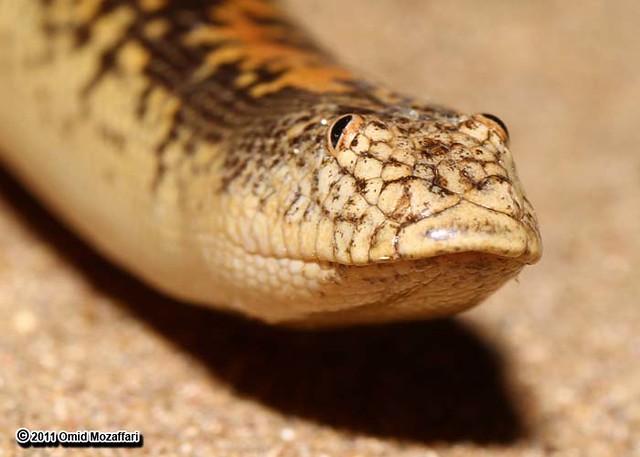
A similar species, but found in Saudi Arabia and Oman instead. Arabian sand boas (Eryx jayakari) appear in the driest, most scorching sand dunes, where they again bury themselves in shallow layers of sand and lurk with just their eyes poking out, in order to hide their bulk yet still scan the horizon for approaching mice. When their prey arrives, which includes Cheesman’s gerbils and Slevin’s sand geckos, they leap out in a shower of sand.
Arabian sand boas constantly appear on online lists of the wackiest looking snakes. They look like a loveable children’s toy, not a sinister serpent that all small mammals should fear. It’s a combination of several things: an unusually shaped snout for burrowing, eyes positioned unusually high on their head to allow vision while buried in sand. Their vision fields also overlap to grant them binocular vision, and then there’s the strangely shaped pupils.
Arabian sand boas average at 35-40cm, and their territory has no overlap with the Egyptian sand boa. This species can be tricky to find in studies, yet scientists have developed an ingenious solution: following the imprints of their slither tracks up sand dunes.
| 3 | Elegant sand boa |
One of the most mysterious and least researched Eryx sand boas. The elegant sand boa (Eryx elegans) inhabits northeast Iran, Turkmenistan and Afghanistan. They inhabit only the most remote areas, especially canyons and gorges, where they love to lurk under loose rocks and slabs, for shelter against the harsh elements. They’re believed to be nocturnal, yet have also been seen moving by day.
How they look is one fact we can be sure about. Elegant sand boas tend to be short, with a maximum of 40cm. They’re drabber in colour compared to Arabian sand boas, with a beige or grey base of scales overlaid with slightly darker blotches. This is a moderately thick snake only. Elegant sand boas also appear under plants in dry shrubland, and generally appear from 800 to 2400 meters above sea level. The scant evidence we have suggests that their diet is similar to most Eryx sand boas, as they’ve eaten mice and voles in captivity. Their scales are slightly keeled rather than 100% smooth, hinting that they burrow less than their sand-diving cousins.
| 4 | Rough-scaled sand boa |
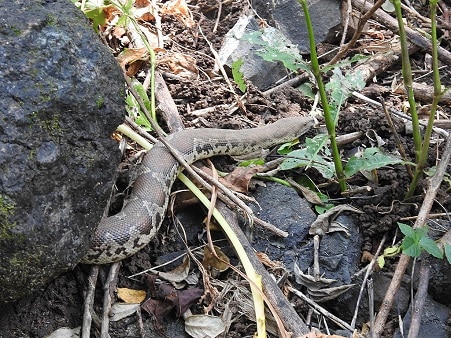
A common Indian species. While rough-scaled snake boas (Eryx conicus) are efficient sand burrowers like their kin, they have relatively flexible habitats, and are just as likely to appear in normal villages or town outskirts as in remote deserts. Eryx conicus has patterns which mimic the deadly Russell’s viper, hoping to gain a shield via mimicry. They lurk in soft sand or soils like other members, leaping out to start prey. One of its folklore nicknames is mannutheeni, or sand-eater. Eryx conicus is confirmed to prey on birds like the ashy priana and thick-bodied reptiles like the Bengal monitor (Varanus bengalensis).
Instead of fully smooth, Eryx conicus has slightly keeled scales for the most part. However, these gain in sharpness as the tail approaches, so that touching the tail while they squirm can actually be painful. This difference in sharpness from head to toe is clearly discernible in images.
Eryx conicus is superb at detecting even the slightest sound vibrations. This is always a blotchy species, unlike the consistently brown John’s sand boa that also inhabits India. These two species overlap, although rough-scaled sand boas are more widespread overall. Eryx conicus inhabits virtually all of India, as well as Pakistan, extending northwards beyond Islamabad. They’re also found in Nepal, Bangladesh, and the island of Sri Lanka.
| 5 | Desert sand boa |
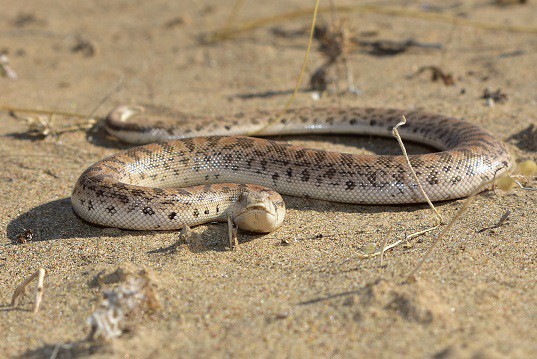
One of the smaller sand boas, with a length of 35-55cm. Desert sand boas (Eryx miliaris) live to the northeast of Arabian sand boas, which themselves live to the northeast of Egyptian sand boas. Their range primarily includes Iraq, Afghanistan, and various less known “stans”: Turkmenistan, Uzbekistan, Kyrgyzstan, Tajikistan. Their westernmost point lies in southern Russia, just north of Georgia, while to the east they reach the wilderness of Mongolia. This makes them the most widespread sand boa in terms of raw geographical territory covered.
Desert sand boas are fairly similar to Arabian sand boas, as they’re most closely related. They have smooth scales, hunt by diving into sand, and have eyes positioned high on their skull for superior vision while buried. However, they tend to be a slightly duller grey or beige, while the Arabian sand boa has fiery orange patches.
Desert sand boas feed on mammals and are easy to keep alive with mice in captivity. However, according to this report, they face a grave obstacle, as one captive Eryx miliaris ended up severely ill after swallowing large quantities of sand.
| 6 | Whitaker’s boa |
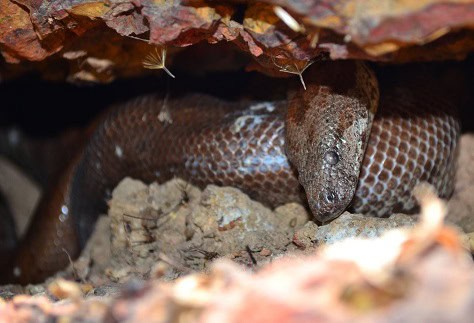
A 70cm species found exclusively in India. Whitaker’s sand boa (Eryx whitakeri) has a much narrower range than the rough-scaled sand boa, as it only inhabits the western Ghats mountain range of India’s southeast. As this range covers nearly 1000 miles from north to south, they still have a large territory.
Whitaker’s sand boas overlap with such western Ghats creatures as king cobras and Malabar pitvipers. Sometimes they fall victim to other snakes, such as the neurotoxic Indian krait. They share the liking for burrowing of other Eryx sand boas, although they rarely appear in actual sandy areas. Of the 12, this is the least likely to appear in deserts, as the western Ghats is a relatively moist mountain range. Rocky, hilly slopes, disused agricultural land and even university campuses are places you may find Whitaker’s sand boa.
Eryx whitakeri is considered to be much more docile than the rough-scaled sand boa. They virtually always default to escape, and if encountered in the open, they’re very slow and sluggish. That said, they can enter an aggressive mode, and if so, their strike speed accelerates to ferocious levels you’d have never previously believed possible. When timid, they often make ball of coils in which they hide their head.
| 7 | Red sand boa |
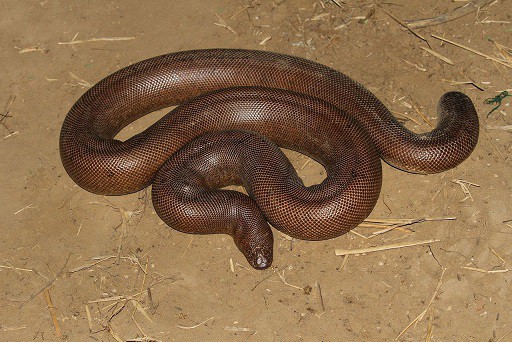
John’s sand boa (Eryx johnii) is the second most common sand boa in India after the rough-scaled form. Compared to the rough-scaled and Whitaker’s, this species is far easier to identify. Those two share dark blotchy patterns, intended to mimic vipers, but this species is generally a consistent muddy brown, or even red. If they do have patterns, they tend to be large bands encircling the lower body.
Narrow nostrils, tiny eyes, and a spade-shaped snout are other ways to recognise this non-venomous constrictor. Rocky foothills and dry, semi-desert plains are their favourite habitats, and their borrowing skills are equally amazing as other Eryx members. Red sand boas prey on the sand boa staples like mice and rats.
This is the largest sand boa worldwide, at a maximum of 120cm. John’s sand boas also have the most superstition of any Eryx member. It’s believed that keeping them as a pet brings good luck, and that consuming its meat cures AIDs. This has fueled an illegal trade operated by gangs, and in 2012 four suspected smugglers were arrested in possession of one. Trading red sand boas is illegal under India’s Wildlife Protection Act of 1972. Red sand boas are also popular with snake charmers on the street.
| 8 | Eryx somalicus |
Some sand boas have been researched since the 1700s, particularly the Indian members, thanks to British naturalists collecting specimens in jars and bringing them back to London. But Eryx somalicus, AKA the Somalian sand boa, is one of the more mysterious ones again. This species is found in Ethiopia and Somalia in far eastern Africa.
Somalian sand boas seem relatively short, as the largest known individual so far measured 39cm in total. The few images show a dark back with intermittent white bars, and circular markings low down on its flanks, adjacent to a pale belly.
Research is scarce, but Somalian sand boas have been found at altitudes from 0 to 1150 metres. They seem more flexible in their habitats, as they’ve been found in dry scrubland, shrub steppe, open woodland, and even beaches. One Somalian sand boa was found in “sandy country with patches of grass and scattered large thorn trees”. This was found with half of its body in a hole in the ground. They have the classic tapering snout of snakes which love to burrow in soft sand, and they seem relatively non-aggressive. As for their diet, one Somalia sand boa was found with a gecko in its stomach.
| 9 | Javelin boa |
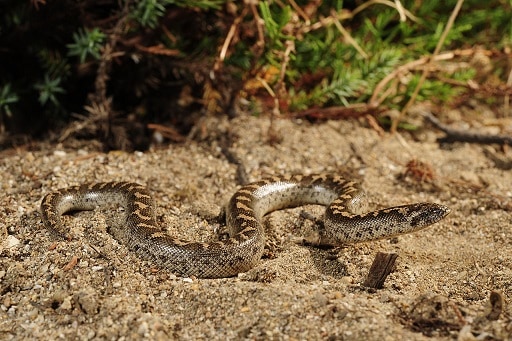
Supposedly named after an ancient Greek method of warfare, where they would seize these snakes and hurl them into opposing armies, to inspire fear and terror. Javelin boas (Eryx jaculus) use the usual hunting method of burying themselves then exploding out in a shower of sand particles to ambush unsuspecting mammals. This species is found in dry hillsides, and semi-deserts, but not true deserts. Any relatively dry area with soft soils to bury themselves in is game for this snake.
Eryx jaculus is intermediate in length for the Eryx family, as the largest ever Egyptian individual measured 83.8cm. It has a fairly short tail, at an average of 8% of total body length. Javelin sand boas have richly detailed patterns rather than a monolithic brown colour. One of its recognisable ID signs is a dark line connecting each eye to the corner of its mouth. According to a study from Sicily, over 70% of their diet was mammals, but they also eat reptiles and occasionally insects.
Eryx jaculus is one of the more wide-ranging species, as in the west, they just reach Morocco, while in the east, they spread to extreme southern Russia and Georgia. They can be found at sea level to 2000 meters, but in Armenia they’ve been found at 2354 metres. Javelin boas are the most commonly found Eryx member in Israel.
| 10 | Saharan sand boa |
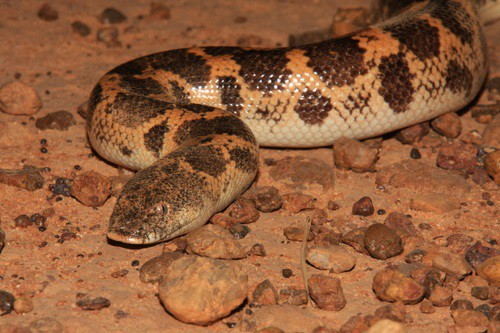
Nigeria’s main sand boa. The Saharan sand boa (Eryx muelleri) measures up to 80cm, and despite the name, they don’t appear in true sand deserts. Their main habitats include dry savannah, and sandy transition zones with shrubby vegetation. One of their classic characteristics is a fleshy appendage on the tail, which snake enthusiasts call a “claw”. The purpose of this claw is unknown, and this is a different to the Egyptian sand boa found in Kenya, which has no such claw.
Eryx muelleri is found in various sub-Saharan areas, never north of the Sahara. Their hotspots include northern Nigeria, Benin, southern Niger, and they reach as far west as Senegal. They’re mainly found in western areas of the sub-Sahara; Nigeria is the furthest they reach east.
Eryx muelleri has a very similar colour scheme to the Arabian sand boa. There’s fiery orange, contrasting sharply against black, with a white belly. However, the black patterns are much blotchier, rounder and larger in Eryx muelleri, rather than scattered with many fine patterns. Elsewhere, they have the same spade-shaped snout, vertical pupils, and weird eyes that look like they’ve been stitched on with a sewing box. All reports suggest that this is a tame and docile species.
